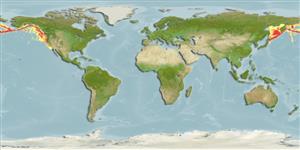Classification / Names
Common names from other countries
Main reference
Size / Weight / Age
Max length : 210 cm TL male/unsexed; (Ref. 56527); common length : 85.0 cm male/unsexed; (Ref. 56527); max. published weight: 86.0 kg (Ref. 56527); max. reported age: 56 years (Ref. 39270)
Length at first maturity
Lm ?, range 65 - 100 cm
Environment
Marine; bathydemersal; non-migratory; depth range 140 - 3500 m (Ref. 50550), usually 700 - 1100 m (Ref. 56476)
Climate / Range
Deep-water, preferred ?; 62°N - 26°N, 143°E - 115°W (Ref. 1371)
Distribution
North Pacific: northern Japan to the Okhotsk and Bering seas, east to the Gulf of Alaska, south to northern Baja California in Mexico.
Countries | FAO areas | Ecosystems | Occurrences | Introductions
Short description
Dorsal
spines
(total): 2;
Dorsal
soft rays
(total): 7-9;
Anal
spines: 0;
Anal
soft rays: 131. Snout low, slightly protruding beyond the large mouth, without a spinous terminal scute. Scales small, slightly oblong, with moderate-sized median ridge, without spines or with few weak spinules, and 0 to 5 much lower, non-spinulated ridges laterally on exposed field. Swim bladder small, with 2 retia mirabilia. Gray-brown on head and body, each scale with a prominent dark posterior border, fins and lateral line darker; black in mouth, gill cavity, and on peritoneum (Ref. 6885). Branchiostegal rays: 6-6; pyloric caeca: 12-16;
IUCN Red List Status (Ref. 115185)
Threat to humans
Harmless
Human uses
Fisheries: commercial
More information
ReferencesAquacultureAquaculture profileStrainsGeneticsAllele frequenciesHeritabilityDiseasesProcessingMass conversion
Tools
Special reports
Download XML
Internet sources
Estimates of some properties based on models
Phylogenetic diversity index
PD50 = 1.0000 many relatives (e.g. carps) 0.5 - 2.0 few relatives (e.g. lungfishes)
Trophic Level
4.3 ±0.7 se; Based on diet studies.
Resilience
Very Low, minimum population doubling time more than 14 years (tmax >30)
Vulnerability
High to very high vulnerability (70 of 100)
Price category
